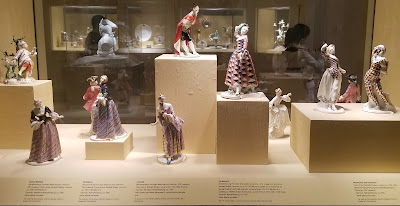Yesterday, I was at the Metropolitan Museum of Art, and I took photos of some of the ceramic figurines they have of characters from commedia dell'arte.
Commedia in the 18th century, when the figurines were produced, had grown to be more refined than the rough-and-tumble improvisations that originated in Italy. It had also spread to France and later across Europe, which is why some of the porcelain miniatures were manufactured in Germany.
One of the most famous stock characters in commedia, Isabella, was named for the actress who made the character type famous. Isabella Canali, whose married name was Andreini, helped lead the commedia troupe I Gelosi to become one of the most famous in the world in the 16th century. She frequently played sexy young widows who drove the plot by maneuvering to marry a young man she loved. Subsequent witty and wily heroines tended to bear the name Isabella, a lasting tribute to her talents.
Here's a photo I snapped of the Isabella figurine at the Met. It's accession number 1974.356.527 if you want to look it up on the Met's website, but unfortunately they just have a black-and-white image. Click on this one to enlarge it and get a sense of what the miniature looks like in full color. The violet tones make her costume stand out without being garish.
Harlequin's costume, on the other hand, is just garish. Originally known as Arlecchino in Italy, Harlequin was the most famous of the zanni. These were servant characters who engaged in slapstick antics. In fact, Harlequin generally carried a literal slapstick, a wooden bat that would make a slapping sound when it stopped just short of hitting someone. This allowed the actors to perform violent physical comedy without actually hurting one another.
This figurine is one of several with the accession number 1974.356.526. Harlequin's tight-fitting suit was originally covered with patches, but gradually these transformed into multi-colored diamonds or triangles. He also wore a black mask, which was not originally intended to be a form of racial impersonation, but multiple paintings from the 18th century (when Black servants became more common in France) depict as Harlequin models who are clearly of African descent.
Frequently paired with Harlequin was a female servant named Colombina or Colombine. She would often wear a dress that had the same pattern as Harlequin's outfit, and she was sometimes known as Harlequina, which is what the Met has named this figurine, accession number 50.211.251.
Colombine was not the only female servant character, but she was the most popular one, exchanging witty barbs with Harlequin in a sassy and sexy manner. Other times, commedia plays would introduce a country girl named Franceschina, whose coarse manners offset the more refined attitude of Colombine. Both of them were allowed more liberties with their humor than the respectable Isabella.
Isabella, Harlequin, and Colombine were all sympathetic characters, but commedia also needed some good villains, or at least blocking characters to get in the way of the lovers.
Sometimes this was Dottore, who was not necessarily a medical doctor, but might be a doctor of law or philosophy. Other times, this function was filled by Pantalone, later known as Pantaloon.
Pantalone was a greedy old man who frequently had an itch for Isabella. Originally he spoke with a Venetian accent and tried to disguise his age by wearing tight-fitting red breeches. In earlier commedia, he might try to snatch the heroine for himself, but later writers, like Carlo Goldoni, softened the character. In Goldoni's The Servant of Two Masters, Pantalone is far more human.
Here's the figurine the Met labeled as Pantaloon. (The accession number is the same as for Harlequin.) In this case, it's his cape-like coat that's red rather than his breeches.
If you're at the Met on Fifth Avenue, you can currently see all of these miniatures on view in Gallery 533. Even if they are not exact reproductions of the actors who strutted on the stage in the 18th century, they at least give us a good idea of what their costumes and physical mannerisms might have looked like.




